

|
Rx60-1 Instructions (v611)
|
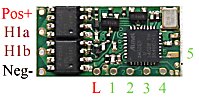
|
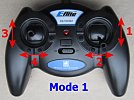
|
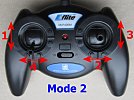
|
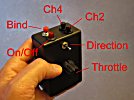
|
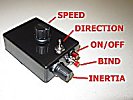
|
1. DEFAULT SETUP
|
Item |
Setting | Details |
|
Purpose: |
Rx60-1 |
Train with Joystick transmitter Train with Tx20 with 3 function buttons Train with Tx21 with 1 function button |
|
Red wire positive (+) Black wire negative (-) |
Battery |
3-13v Observe polarities |
|
H1 output |
Motor Ch1 (Throttle) Ch3 (Direction) |
Integrated forward/reverse ESC for brushed motors Low off (full movement speed control) Move switch in required direction and release (if self-centering) Only effective when stopped |
|
P1 |
Front Light |
Auto action, LED2 enabled |
|
P2 |
Rear Light |
Auto action |
|
P3 |
On/Off |
Function 1 (Ch2) On when channel is Low, Momentary action |
|
P4 |
On/Off |
Function 2 (Ch4) On when channel is Low, Momentary action |
|
P5 |
On/Off |
Bind button (Ch5) Start off, toggle when channel is Low, Latching action |
|
L input (from v611-14) |
Auto-detect |
Monitors battery when used with a voltage booster NB: The L input does not work on receivers with v611-13 or earlier software (eg: marked '11/13') |
|
Arming |
Enabled |
Ch1 to low position (off) |
|
Low Voltage Cutoff |
Enabled |
Led 5-flash if triggered (LVC) |
| Cruise control | Enabled |
Outputs 'hold' last position on signal loss/Tx switched off |
| Inactivity Sleep | Enabled |
Invoked after 1hour, Switch Rx off and on to restart |
| LVC Sleep | Enabled |
Invoked 5 minutes after LVC event, Charge battery |
|
Battery Voltage flashes |
Enabled (from v611-15) |
Press Bind button (Ch5) briefly and count flashes as described here Flashes appear on LED2 output (P1) |
2. EXAMPLE CONNECTIONS:
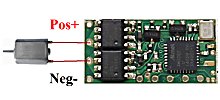
|
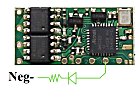
|
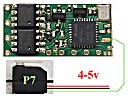
|
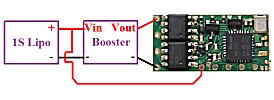
|
'P' outputs are either 3.3v or 0v (ground). Leds need resistors to limit current to no more than 20mA. High brightness leds allow a lower current which is preferred (eg: 2-5mA). Google will reveal how to select resistor values but 220-470ohms will be safe starting values.
The 'L' pad monitors the voltage of a battery when used with a voltage booster. This allows the receiver/motor to be powered with a boosted voltage and benefit from the convenience of a smaller battery, typically a single lipo. The receiver will cut power to the motor when the battery voltage falls to the LVC voltage.
3. BINDING
Bind once:
1. Switch Rx on and wait ~20s until led flickers fast.
2. Switch Tx on in bind mode.
3. Rx led should flash slowly; wait for it to go solid.
Change distance between Tx/Rx if binding does not work.
4. LED:
Led On = perfect reception (real-time indicator).
1 flash = Scanning (~2sec between flashes; no signal or not bound if never stops).
2 flash = Model currently not selected (Selecta).
5 flash = LVC/Brownout (voltage went too low; check battery/motor load).
5. PAPERCLIP CHANGES:
The following changes can be made by simply shorting two pads together (eg: with a paperclip):
1. Perform a 'Hard reset' (factory reset).
2. Change motor control between 'low off' and 'center off'.
3. Enable/disable LVC (eg: when using Nicads, NiHMs, LiFe cells).
4. Enable/disable Selecta.
5. Enable/disable Cruise Control/Failsafe.
'Paperclip' changes
6. PROGRAMMING:
This receiver has many other options that are described on the features page.
These are changed using a technique called 'programming': v611.